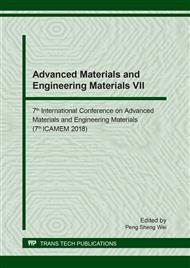[1]
YUAN Z T, ZHANG Q D, LIU J T. Influence and Mechanism of Metal Ions on Flotation of Molybdenite[J]. Journal of Northeastern University (Natural Science), 2016, 37(7):1013-1016.
Google Scholar
[2]
Zhang Qidong. Study on Classification Floatation of XinHua Molybdenum Ore [D]. Northeastern University, (2011).
Google Scholar
[3]
Beattie D A, Le H, Kaggwa G B N, Ralston J. The effect of polysaccharides and polyacrylamides on the depression of talc and the flotation of sulphide minerals[J]. Minerals Engineering, 2006, 19:598-608.
DOI: 10.1016/j.mineng.2005.09.011
Google Scholar
[4]
Kelebek S, Smith S Y G W. Wetting behavior of molybdenite and talc in lignosulphonate/MIBC solutions and their separation by flotation[J]. Separation Science & Technology, 2006, 36(2):145-157.
DOI: 10.1081/ss-100001072
Google Scholar
[5]
Lotter N O, Bradshaw D J, Becker M, et al. A discussion of the occurrence and undesirable flotation behavior of orthopyroxene and talc in the processing of mafic deposits[J]. Minerals Engineering, 2008, 21(12-14):905-912.
DOI: 10.1016/j.mineng.2008.02.023
Google Scholar
[6]
LONG Tao, FENG Qi-ming, LU Yi-ping, et al. Depression and dispersion effect of carboxy methyl cellulose on flotation of layered magnesium-silicates[J]. The Chinese Journal of Nonferrous Metals, 2011, 21(5):1145-1150.
Google Scholar
[7]
Zhao C H, Chen J H, Bo-Zeng W U, et al. Density functional theory study on natural hydrophobicity of sulfide surfaces[J]. Transactions of Nonferrous Metals Society of China, 2014, 24(2): 491-498.
DOI: 10.1016/s1003-6326(14)63087-9
Google Scholar
[8]
STIRLING A, BERNASCONI M, PARRINELLO M. Ab initio simulation of water interaction with the (100) surface of pyrite[J]. The Journal of Chemical Physics, 2003, 118: 8917-8926.
DOI: 10.1063/1.1566936
Google Scholar
[9]
Chander S, Fuerstenau D W. On the natural floatability of molybdenite[J]. Transaction of American Institute of Mining, Metallurgical, and Petroleum Engineers, 1972, 252(1):62-69.
Google Scholar
[10]
Braga P F A, Chaves A P, Luz A B. The use of dextrin in purification by flotation of molybdenite concentrates[J]. International Journal of Mineral Processing, 2014, 127(10):23-27.
DOI: 10.1016/j.minpro.2013.12.007
Google Scholar
[11]
ZHANG Q D, YUAN Z T, LIU J T, et al. Effect of glucan on flotation separation of molybdenite and talc[J]. The Chinese Journal of Nonferrous Metals, 2016, 26(4):884-890.
Google Scholar


